A Cat Sleeps with Its Open Eyes
Updated: 23 Jul 2024
881
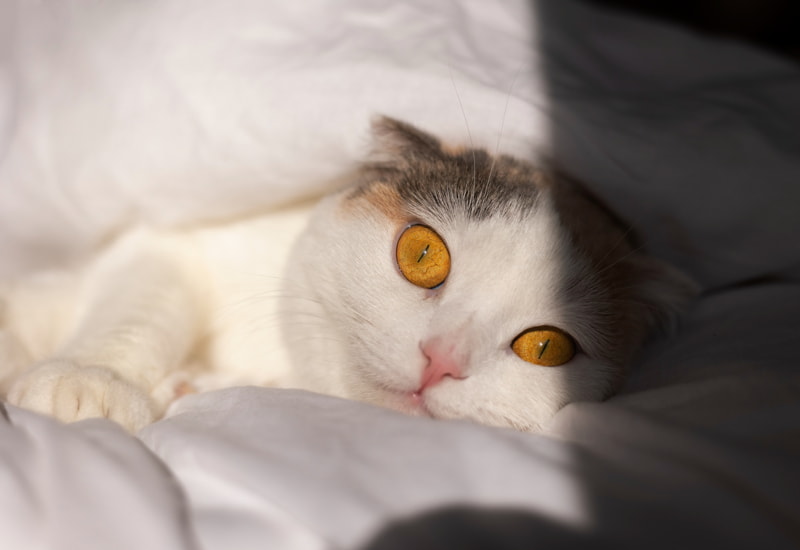
Is It Ok If a Cat Sleeps With Its Open Eyes? Cats can indeed sleep with their eyes open, which is a behavior rooted in their evolution and physiology.
Cats are interesting animals with strange habits and behaviors that they do, including when they sleep. This is something that usually leaves many owners confused each time they see their animal buddies taking it slow while having their eyes wide open.
Cats developed this ability as a survival mechanism. In the wild, being able to rest while still maintaining some awareness of their surroundings could mean the difference between life and death.
The third eyelid, or nictitating membrane, is a unique feature that allows cats to protect their eyes while still allowing some visual input. This translucent eyelid can cover part of the eye during sleep.
Feline Sleep Cycle
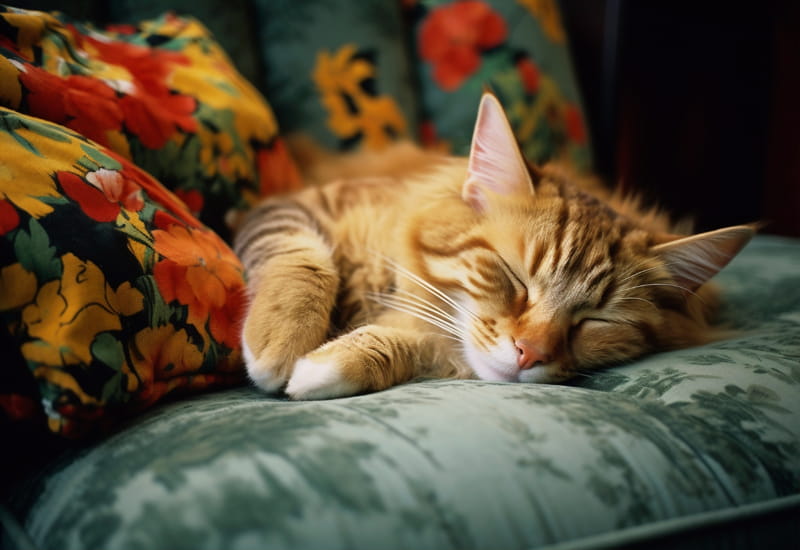
The Rem Sleep (Rapid Eye Movement)
This is the stage where cats dream. It’s similar to human REM sleep, but cats experience it in shorter bursts, usually 5-10 minutes at a time.
Non-REM Sleep:
This makes up the majority of a cat’s sleep time. It’s divided into light and deep sleep. The light sleep stage is particularly important for understanding why cats might sleep with their eyes open. This part discusses the specific circumstances when cats are more likely to exhibit this behavior.
Light sleep stages are when cats are most likely to keep their eyes partially open. This allows them to quickly become alert if needed. Cats might be more inclined to sleep this way in unfamiliar or potentially threatening environments.
Understanding Cat Sleep
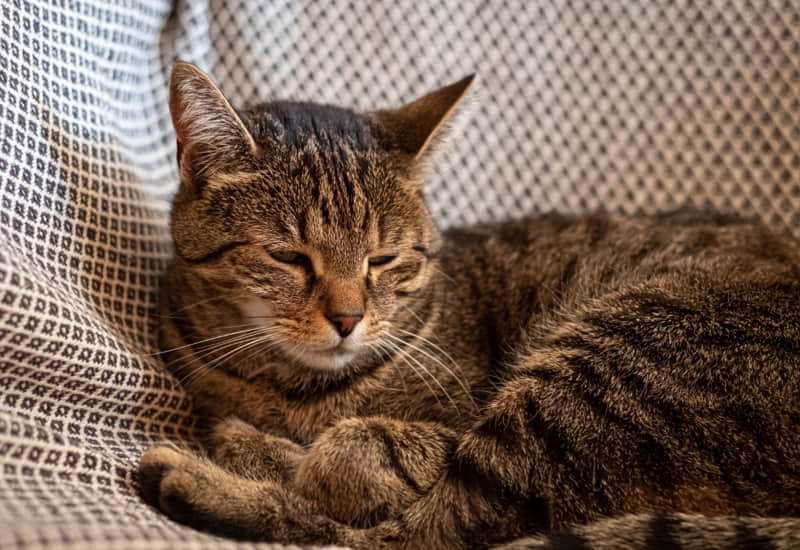
Cats are known for their unique sleeping habits. On average, a cat sleeps between 12 to 16 hours a day, often napping in short bursts throughout the day and night.
Their sleep cycles consist of light sleep and deep REM sleep, during which they may dream. This is where the peculiar behavior of sleeping with their eyes open.
Top 20 Sleeping Positions and What Their Mean
- Curled Up in a Ball: This position helps cats conserve body heat and protect vital organs. It often indicates the cat feels safe but might be a bit chilly.
- On their Side: This relaxed position shows the cat feels secure in its environment. It allows for quick movement if needed.
- On their Back: When a cat sleeps on its back with its belly exposed, it’s demonstrating complete trust and contentment. This is one of the most vulnerable positions for a cat.
- Loaf Position (paws tucked under): This position allows the cat to rest while remaining somewhat alert. It’s often seen when cats are content but not deeply sleeping.
- Paw Over Face: This cute position might be the cat’s way of blocking out light or seeking some privacy. It can also be a way to keep their nose warm.
- In a Box or Enclosed Space: Cats seek out small, enclosed spaces because they feel secure. This mimics their instinct to hide from predators in the wild.
- Stretched Out: This position often indicates the cat is trying to cool down. It might also show they feel very comfortable and safe in their environment.
- Half on their Back: This position balances relaxation with readiness. The cat feels safe enough to expose part of its belly but can quickly roll over if needed.
- Belly Up: Similar to sleeping on their back, this position demonstrates extreme trust and comfort. However, most cats don’t appreciate belly rubs even in this position.
- On Top of Objects: Cats often seek high places to sleep as it gives them a good vantage point and makes them feel safe from potential threats.
- Sitting Up: If a cat appears to be sleeping while sitting up, they’re likely just dozing and staying alert to their surroundings.
- Contorted or Twisted: Cats are extremely flexible and may sleep in positions that look uncomfortable to us but are perfectly cozy for them.
- On Stomach: This position allows for quick action if needed but also shows the cat feels relaxed enough to rest.
- Huddling with Other Cats: This social sleeping behavior helps cats bond and stay warm.
- In a Sunny Spot: Cats love warmth, and sleeping in a patch of sunlight helps them regulate their body temperature.
- On with Human: When a cat sleeps on or against their human, it shows affection and trust.
- Head Pressed Against Objects: While cute, persistent head pressing can be a sign of a medical issue and should be checked by a vet.
- Sprawled Out on their Side: This position often indicates the cat is in a deep, comfortable sleep.
- Tucked into Small Spaces: Like boxes, cats may squeeze into small spaces like drawers or shelves for a sense of security.
- Tail wrapped Around Body: This position helps the cat retain heat and might indicate they’re cold.
Remember, while these positions can give us insights into a cat’s comfort level and mood, individual cats may have their preferences and quirks. Always consider the overall context and your cat’s normal behavior when interpreting their body language.
The Cat Sleep Time
Human beings have different sleep patterns in comparison with cats. Here is the analysis of the cat’s sleep characteristics. Cats are crepuscular animals, meaning they are most active during dawn and dusk.
On average, cats can sleep anywhere from 12 to 16 hours a day, which allows them to conserve energy for hunting and play.
Good Place Where Kittens Sleep at Night
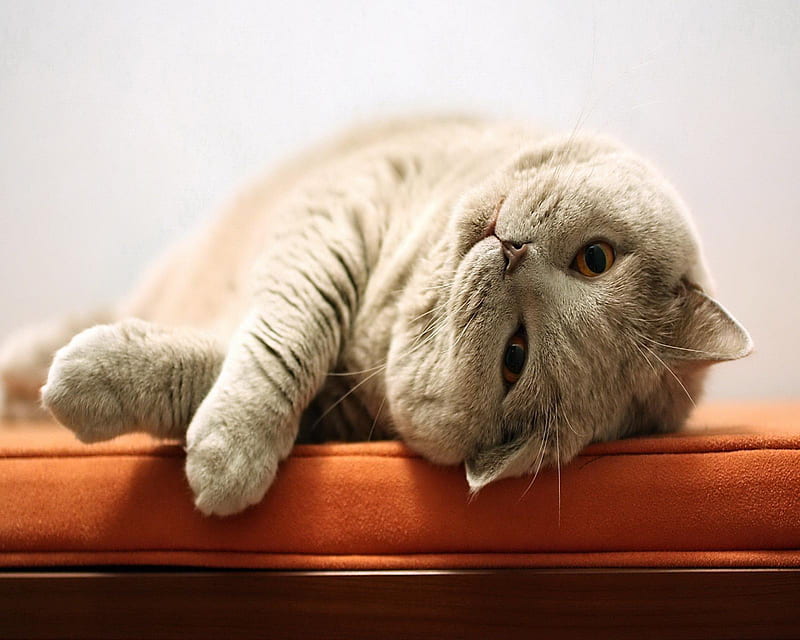
The first night can be crucial for a kitten adjustment. A warm, quiet space with familiar scents can help them feel secure. New kitten owners often wonder where their young pets should sleep, especially during the first few nights at home.
Providing a cozy cat bed becomes essential for their comfort and safety as kittens grow. Many cat owners debate whether to allow their kittens to sleep in bed with them.
Sleep quality sharing a bed with your kitten can impact your sleep quality. Parasites and Infections, there are health considerations to remember when sleeping with your kittens. Training kittens to sleep alone is crucial for their independence.
Tips To Making Your Cat Sleep Peacefully
Helping your cat achieve restful sleep is beneficial for their health and behavior.
- Maintain a Sleep Schedule
- Establishing a routine encourages healthy sleep patterns in cats.
- Dinner Closer to Bedtime
- Strategic feeding times can influence your cat’s sleep habits.
Cat See While Sleeping With Its Eyes Open(A Cat Sleeps With Its Open Eyes)
Understanding cats vision during different sleep phases provides insight into their behavior. Knowing when to intervene if your cat sleeps with eyes open is crucial for their well-being. Exploring the reasons behind this behavior offers a deeper understanding of cats instincts.
Evolutionary Adaptation Of Cats
- Cats are both predators and prey in the wild
- Sleeping with their eyes open allows them to remain vigilant
- This behavior increases their chances of survival in dangerous environments
Environmental Factors
- Unfamiliar or potentially threatening surroundings may trigger this behavior
- Cats in multi-pet households might sleep more vigilantly
- Outdoor cats may be more prone to sleeping with eyes open due to increased risks
Normal Behavior(A Cat Sleeps With Open Its Open Eyes)
- For most cats, sleeping with eyes partially open is perfectly healthy
- It’s a natural part of their sleep cycle and protective instincts
- This behavior doesn’t typically indicate any underlying health issues
Potential Concerns
- Consistently wide-open eyes during sleep may signal a problem
- Eye infections or injuries can prevent a cat from fully closing its eyes
- Neurological issues might affect a cat’s ability to close its eyes properly
Observing Your Cat’s Sleep Habits
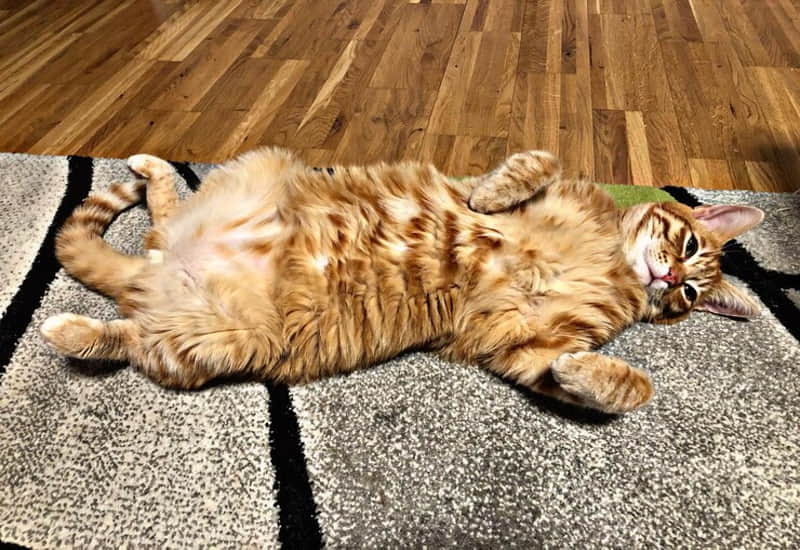
To better understand your cats sleep patterns and ensure their well-being, consider the following tips:
- Monitor the frequency of open-eye sleep
- Observe the extent to which your cat’s eyes remain open
- Note any changes in sleep behavior or eye appearance
- Watch for signs of discomfort or irritation around the eyes
- Pay attention to your cat’s overall sleep duration and quality
If you notice any concerning changes or persistent wide-open eyes during sleep, it’s best to consult with a veterinarian to rule out potential health issues.
Health Implications
This section addresses whether cat owners should be concerned about this behavior. In most cases, sleeping with eyes partially open is normal and not a cause for concern.
However, if a cat’s eyes are consistently wide open during sleep or if there are other unusual symptoms, it could indicate a health problem that requires veterinary attention.
Conclusion
It reiterates that sleeping with eyes open is a normal cat behavior rooted in their evolutionary history. It encourages cat owners to appreciate this unique trait while also staying vigilant about their pet’s overall health and well-being.
Overall, this article aims to educate cat owners about a common but often misunderstood behavior. It combines scientific information about feline sleep patterns with practical advice for pet care, helping readers to better understand and care for their feline companions.
Do cats actually sleep with their eyes open?
Cats don’t truly sleep with their eyes fully open. They may appear to have open eyes while napping due to their third eyelid. This translucent membrane partially covers the eye, giving the illusion of open eyes.
What is the purpose of a cat’s third eyelid?
The third eyelid, or nictitating membrane, protects and moistens the eye. It helps remove debris and distribute tears across the eye’s surface. This membrane also provides additional protection during sleep or while hunting.
How does sleeping with “open” eyes benefit cats?
This adaptation helps cats stay aware of potential threats even while resting. It allows them to quickly respond to movement or danger in their environment. This trait likely evolved as a survival mechanism for wild felines and persists in domestic cats
What percentage of cats are known to sleep with their eyes partially open?
Approximately 10% of cats sleep with their eyes partially open. This condition is known as “third eyelid protrusion” or “nictitating membrane visibility.” It’s more common in older cats and doesn’t usually indicate a health problem.
Please Write Your Comments